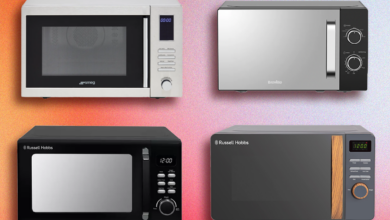Fans vs air conditioners: Which one is right for you when it comes to cooling your home?

Temperatures are soaring across Britain and our homes are heating up. We’re stuck in a pressure cooker of misery and sweat, desperately searching for some cool respite. But while we close the windows, shut the curtains and hunker down inside the bathroom in a ball of tears, inevitably screaming “No, no! It burns”, we need something more.
Breathable bedding, ice cream and face mists will help keep us all comfortable, and are must-have heatwave essentials, but they frankly aren’t going to circulate the air or cool our homes down in any significant way.
If you’re really feeling the heat this summer, it’s time you invested in some actual home-cooling equipment. The two main options are an electric fan or a portable air conditioner. You’ve no doubt already got a fan lying around, the house, the question is: should you upgrade to a portable air conditioner this summer instead?
With heatwaves worsening and becoming more intense and more likely to take place due to climate change, experts are warning the country that we need to start heat-proofing our homes.
There are lots of things to consider when choosing between an electric fan and a portable air conditioner. Is one more effective at cooling a room than the other? How much do they each cost to buy and run? And which one is easier to use? Well, we’re here to help break all that down for you, and more.
Read more:
While both fans and air conditioners work to cool you and your home down, they each do so in a different way, and one is more effective than the other.
First of all, electric fans don’t actually cool the air inside your home like portable air conditioners do, they just cool you down. They do this by pushing the air in the room around, helping the sweat and moisture on your skin evaporate more quickly. The air being circulated by a fan is the same temperature as the air in the room, so while it does provide a current of air, when it’s a particularly hot day, you’ll just be blowing around hot air. You might not feel any cooler.
Portable air conditioners physically lower the temperature inside your home rather than creating an air current. It does this by sucking up the hot air in the room, cooling that air down and then expelling the hot air through an exhaust hose into the outside world. Air conditioners with higher British Thermal Units (BTUs) will be more efficient at cooling larger rooms – the higher the BTU, the larger the room it can cool. If you buy a portable air conditioner with a BTU that’s too low, it won’t work as efficiently.
On extremely hot days, a portable air conditioner, such as the MeacoCool MC series 7000 (£299.99, Amazon.co.uk) will be more effective at cooling an entire room because it will literally be removing the hot air in order to keep the temperature down.
A large, powerful tower fan, such as the Dyson purifier cool autoreact (£399.99, Johnlewis.com) or a ceiling fan with fast rotating blades will help circulate the air in a wider spread, providing a stronger breeze around the entire room, but it won’t actually sap the hot air out of your home.
Electric fans win this one, hands-down. Handheld fans, desk fans, tower fans and even pedestal fans take up far less room than even the smallest portable air conditioners with the lowest BTUs.
While portable air conditioners are technically portable, with powerful models such as the MeacoCool MC 14000 (£479.95, Amazon.co.uk) featuring casters to help you move it around to other rooms, they’re still bulky, heavy and take up a lot of room in your home. And even our favourite portable air conditioners weighed between 20.5kg and 32kg.
You also need to think about the exhaust hose, which needs to be threaded out of a window, and that can be a cumbersome, unwieldy process, especially if you’re using a window seal around the hose for maximum energy efficiency.
Fans, on the other hand, are light and can be neatly packed away when not in use, plus you can easily pick one up if you want to move it to another room. The best fans in our round-up weigh as little as 1kg and as much as 5kg. Good luck trying to hide your portable AC unit in the winter.
MeacoCool MC 14000: £479.95, Amazon.co.uk
Most fans in the UK use between 70W and 150W of power. According to research conducted by price comparison site Uswitch, a 120W electric fan will cost you 2p an hour when its running.
Portable AC units cost around 44p per hour to run. If you use your air conditioner for 4 hours and 18 minutes during the day – the UK average – and 4 hours and 48 minutes at night, it’s estimated that you’ll pay roughly £28 per week.
We’d recommend investing in a smart AC controller, such as the Tado smart AC control V3+ (£74.98, Amazon.co.uk) if you’re going to install a portable air conditioner in your home as this will help you manage and control your unit so that it runs more efficiently.
You also have to think about the cost of the appliance itself. The most expensive fan on our round-up of the best electric fans costs £399.99, while the cheapest desk fan costs £29.99. The most expensive portable air conditioner on our round-up of the best portable AC units costs £949, while the cheapest costs £289.54.
Dyson purifier cool autoreact: £399.99, Johnlewis.com
Tado smart AC control V3+: £74.98, Amazon.co.uk





